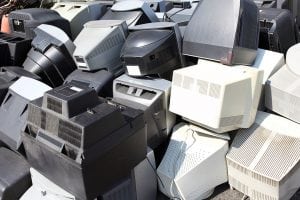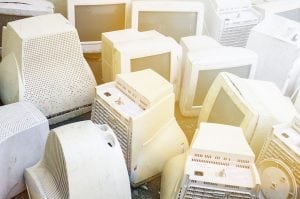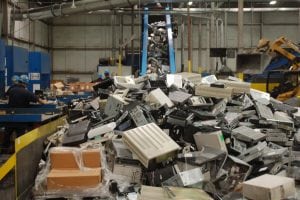 A draft European Union law limits traces of a flame retardant in products to such a low level that it would effectively kill e-plastics recycling on the continent, two industry groups said.
A draft European Union law limits traces of a flame retardant in products to such a low level that it would effectively kill e-plastics recycling on the continent, two industry groups said.

 A draft European Union law limits traces of a flame retardant in products to such a low level that it would effectively kill e-plastics recycling on the continent, two industry groups said.
A draft European Union law limits traces of a flame retardant in products to such a low level that it would effectively kill e-plastics recycling on the continent, two industry groups said.
 A global company has been approved to inspect containers and collect fees on used electronics shipped to an area of the world that has been mired in e-scrap export controversy.
A global company has been approved to inspect containers and collect fees on used electronics shipped to an area of the world that has been mired in e-scrap export controversy.
All 10 citations levied against COM2 Computers and Technologies LLC by the federal Occupational Safety and Health Administration will be cleared by the end of the month, following a settlement agreement made between the agency and the company Oct. 16. Continue Reading
The Occupational Safety and Health Administration has issued 11 citations against dual-certified e-scrap processor COM2 Computers and Technologies LLC, but the company says it is meeting with the agency next week to contest the allegations. Continue Reading
 The online purchase of a new laptop may be convenient, but it could also be supporting a company skirting extended producer responsibility (EPR) laws. A recent report examines the growing global issue.
The online purchase of a new laptop may be convenient, but it could also be supporting a company skirting extended producer responsibility (EPR) laws. A recent report examines the growing global issue.
 A Norwegian proposal that aims to combat marine debris could close the door to e-plastics export markets for U.S. processors.
A Norwegian proposal that aims to combat marine debris could close the door to e-plastics export markets for U.S. processors.
 This story has been updated.
This story has been updated.
Bathroom doors, a water cooler handle, a refrigerator – their surfaces carried lead, cadmium and other hazardous metals, according to studies at two e-scrap facilities.
 Maria Delgado-Loubriel, who runs Legie E-Scrap Recycling in Jacksonville, Fla., faces felony charges for improper management of hazardous e-scrap.
Maria Delgado-Loubriel, who runs Legie E-Scrap Recycling in Jacksonville, Fla., faces felony charges for improper management of hazardous e-scrap.

Material at the Mesquite, Texas ECS Refining facility. E-Scrap News file photo.
E-scrap processor Dynamic Recycling has signed a deal to buy assets from bankrupt company ECS Refining. Meanwhile, environmental and cost complications are popping up around facility cleanup efforts.
 Labeling and storage issues led state regulators to fine eLot Electronics Recycling in New York.
Labeling and storage issues led state regulators to fine eLot Electronics Recycling in New York.
